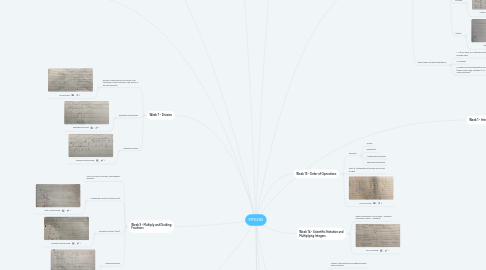
1. Week 4 - Subtraction
1.1. Subtraction
1.1.1. When showing subtraction, show the blocks off the "mat" and display the things you aretaking away on the side. Then take the blocks off the mat and from the side at the same time. On -> What they have (first #) Off -> What you are subtracting
1.2. Expanded Form
1.2.1. Expanded Form SUB.jpg
1.3. Equal Addends
1.3.1. Equal Addends.jpg
1.3.2. Equal Addends (2).jpg
2. Week 6 - Multiplication (Cont.)
2.1. Algorithms (Mult)
2.1.1. Expanded Form (Mult)
2.1.1.1. Expanded Form MULT.jpg
2.1.2. Left to Right (Mult)
2.1.2.1. Left to Right MULT.jpg
2.1.3. Area Model
2.1.3.1. Area Model.jpg
2.1.4. Lattice (Mult)
2.1.4.1. Lattice MULT.jpg
3. Week 2 - Base 10
3.1. Base 10 blocks
3.1.1. Base10.jpg
3.2. Biz-Buzz Game
3.3. Convert from base ten to different bases
3.3.1. Convert to base 10.jpg
4. Week 7 - Division
4.1. Division: Equal amount of groups. The remainder is the numerator, the divisor is the denominator.
4.1.1. Division.jpg
4.2. Repeated Subtraction
4.2.1. Repeated Sub.jpg
4.3. Upwards Division
4.3.1. Upwards Division.jpg
5. Week 8 - Fractions
5.1. Top: Number of pieces Bottom: Size of pieces
5.2. In 4/1 the 4 tells us the number of things, every whole number is a fraction
5.3. Fractions are the first time students will have to understand the smaller number is the bigger number when it comes to the denominator
5.4. Which is bigger?
5.4.1. Bigger.jpg
5.5. Why do we need to find common denominator when we add and subtract but not when we multiply?
5.5.1. Common (1).jpg
6. Week 9 - Multiply and Dividing Fractions
6.1. Set: out of set of models, something is different
6.2. Multiplying Fractions (funky ones)
6.2.1. Mult Fractions.jpg
6.3. Dividing Fractions (KCF)
6.3.1. Dividing Fractions.jpg
6.4. Adding Fractions
6.4.1. Adding Fractions.jpg
7. Week 10 - Solving Decimals
7.1. Solving add/sub/mult Decimals
7.1.1. Line up the decimals (students may find this difficult because some students are unsure whether the decimal is before or after the whole number)
7.1.1.1. Adding Decimals.jpg
7.2. Show adding Fractions
7.2.1. Show Add Fractions.jpg
7.3. Show subtracting Fractions
7.3.1. Show Sub Fractions.jpg
7.4. Show multiplying Fractions
7.4.1. Show Mult Fractions.jpg
8. Week 1 - Intro
8.1. One to one correspondence: when one item it counted for one item.
8.2. Cardinality: When students don't need to count if given a pile of things.
8.3. Subitizing: To identify the number of things in a set by quickly looking at them.
8.4. More or less
8.5. Number recognition
8.6. Counting
8.7. Ploya (4-steps) UnDevCarLo
8.7.1. 1. (Un) Understand the problem
8.7.2. 2. (Dev) Develop a plan
8.7.3. 3. (Car) Put in to action
8.7.4. 4. (Lo) Look back - Does my answer make sense?
9. Week 5 - Multiplication
9.1. Multiplication intro
9.1.1. Mult.jpg
9.2. 3X5: 3 groups of 5 items
9.3. Array: individual dots of points, always going to make a rectangle. Length of rectangle
10. Week 3 - Addition
10.1. Alternative Algorithms: Addition
10.1.1. Expanded Form
10.1.1.1. Expanded Form.jpg
10.1.2. Left to Right
10.1.2.1. Left to Right.jpg
10.1.3. Friendly Numbers
10.1.3.1. Friendly Numbers.jpg
10.1.4. Scratch
10.1.4.1. Scratch Meathod.jpg
10.1.5. Lattice
10.1.5.1. Lattice.jpg
10.2. What makes the best algorithms?
10.2.1. 1. If it will work, no matter how hard the problem gets
10.2.2. 2. Efficient
10.2.3. 3. Based in solid mathematical principles (when place value matches (3 VS 300 as a carried number)
11. Week 11 - 2 Color Counters
11.1. When doing integers, the red side is negative and the other colored side is positive
11.2. Color Counters.jpg
11.3. Zero pairs: a colored tile and a red tile canceling out using pairs
11.4. Zero bank: bunch of zero pairs, physical way of showing negative numbers. Only do zero banks if you have enough of a take away
12. Week 12 - Divisibility Rules
12.1. Divisability Rules.jpg
13. Week 13 - Adding and Subtracting Integers
13.1. Always stack positive and negative signs when showing
13.2. Zero banks!
13.3. IMG-6774.jpg
13.4. IMG-6775.jpg
14. Week 14 - Scientific Notation and Multiplying Integers
14.1. When multiplying: SAME signs = Addition DIFFERENT signs = Negative
14.2. IMG-6776.jpg
15. Week 15 - Order of Operations
15.1. GEMDAS
15.1.1. Group
15.1.2. Exponents
15.1.3. Multiplication/Division
15.1.4. Addition/Subtraction
